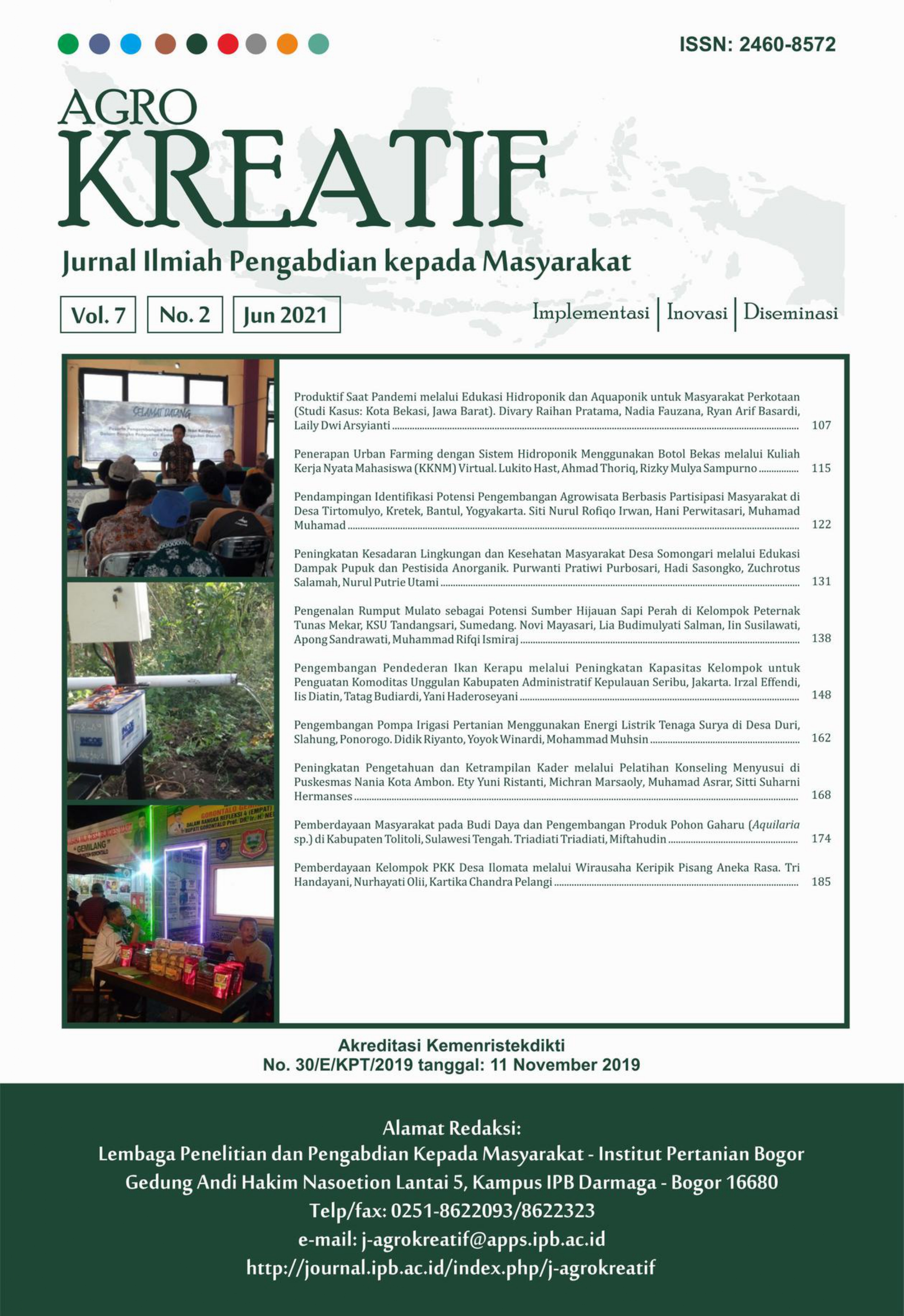Peningkatan Kesadaran Lingkungan dan Kesehatan Masyarakat Desa Somongari melalui Edukasi Dampak Pupuk dan Pestisida Anorganik
Abstract
Somongari Village, located in Purworejo District, Central Java Province, is well-known as a producer of durian and mangosteen fruits. The income of Somongari Villagers depends on this commodity, however because of durian and mangosteen can only be harvested during a specific season, the villager plans to build vegetable houses for their daily needs. Based on the data obtained through Forum Group Discussion (FGD) with representatives of the villager and farmer group, the villager had not used organic fertilizers and pesticides. The practicality and fast yield of inorganic fertilizers and pesticides are the reasons villagers use them more. In contrast, the application of inorganic fertilizers and pesticides can hurt the environment and human health. Therefore, education was carried out for the Somongari villagers to increase the knowledge and awareness of environmental sustainability and health, primarily due to inorganic fertilizer and pesticide impact. The method used in this event was include preparation (coordination and problem identification through FGD), implementation (delivery of material), evaluation, and follow-up plans. After this activity, public knowledge of the impact of inorganic fertilizers and pesticides has increased. It can be seen from the pretest and post-test scores, respectively, before and after the material's presentation. In addition, the success of this program can also be seen from the awareness of the villager to make follow-up plans related to the production of organic fertilizers and pesticides.
Downloads
References
Amilia E, Joy B, Sunardi. 2016. Residu Pestisida pada Tanaman Hortikultura (Studi Kasus di Desa Cihanjuang Rahayu Kecamatan Parongpong Kabupaten Bandung Barat). Jurnal Agrikultura. 27(1): 23‒29. https://doi.org/10.24198/agrikultura.v27i1.8473
[BSN] Badan Standardisasi Nasional. 2008. SNI 7313:2008 Batas Maksimum Residu Pestisida pada Pertanian.
Fatmawati, Suparmin. 2015. Studi Pemakaian Pestisida pada Petani Kentang di Desa Dieng Kecamatan Kejajar Kabupaten Wonosobo Tahun 2015. Buletin Keslingmas. 34(4): 242‒249. https://doi.org/10.31983/keslingmas.v34i4.3038
Fitriadi BR, Putri AC. 2016. Metode-metode Pengurangan Residu Pestisida pada Hasil Pertanian. Jurnal Rekayasa Kimia dan Lingkungan. 11(2): 61‒71. https://doi.org/10.23955/rkl.v11i2.4950
Hamtiah S, Dwijatmiko S, Satmoko S. 2012. Efektivitas Media Audio Visual (Video) terhadap Tingkat Pengetahuan Petani Ternak Sapi Perah Tentang Kualitas Susu di Desa Indrokilo Kecamatan Ungaran Barat Kabupaten Semarang. Animal Agriculture Journal. 1(2): 322‒330.
Maden EVD, Gordijn F, Wulansari M, Koomen I. 2015. Panduan Pelatihan Paparan Pestisida di Ladang dan Pengaruh pestisida terhadap Kesehatan. Veg Impact, Netherland (NL): Wageningen UR.
Maghfoer MD. 2018. Teknik Pemupukan Terung Ramah Lingkungan. Malang (ID): Universitas Brawijaya Press.
Marizi L, Novita N, Setiawati D. 2019. Efektivitas Media Audiovisual tentang Kontrasepsi Intra Uterine Device terhadap Pengetahuan Wanita Usia Subur. Jurnal Kesehatan Poltekkes Palembang. 14(1): 7‒12. https://doi.org/10.36086/jpp.v14i1.280
Media Indonesia. 2019. Pemerintah Tertibkan Peredaran Pupuk dan Pestisida. [Internet] [Diakses pada: 28 Mei 2020]. Tersedia pada: https://mediaindonesia.com/ekonomi/238315/pemerintah-tertibkan-peredaran-pupuk-dan-pestisida.
Pawitra AS. 2012. Pemakaian Pestisida Kimia terhadap Kadar Enzim Cholinesterase dan Residu Pestisida Dalam Tanah. Jurnal Ilmiah Kesehatan Media Husada. 01(01): 19‒30. https://doi.org/10.33475/jikmh.v1i1.59
Puspawati C, Haryono P. 2018. Bahan Ajar Kesehatan Lingkungan Penyehatan Tanah. Jakarta (ID): Pusat Pendidikan Sumber Daya Manusia Kesehatan Edisi Tahun 2018, Kementerian Kesehatan Republik Indonesia.
Sumiati A, Julianto RPD. 2018. Analisa Residu Pestisida di Wilayah Malang dan Penanggulanganya untuk Keamanan Pangan Buah Jeruk. Buana Sains. 18(2): 125‒130. https://doi.org/10.33366/bs.v18i2.1185
Syahri, Somantri RU. 2017. Studi Dampak Aplikasi Pestisida terhadap Residu yang Ditimbulkannya pada Sayuran di Sumatera Selatan. Dalam: Prosiding Seminar Nasional Lahan Suboptimal 2017. Palembang (ID): Universitas Sriwijaya, 19‒20 Oktober 2017.
Taufik I. 2011. Pencemaran Pestisida pada Perairan Perikanan di Sukabumi-Jawa Barat. Media Akuakultur. 6(1): 69‒75. https://doi.org/10.15578/ma.6.1.2011.69-75
Yuantari MG. 2011. Dampak Pestisida Organoklorin terhadap Kesehatan Manusia dan Lingkungan serta Penanggulangannya. Dalam Prosiding Seminar Nasional Peran Kesehatan Masyarakat dalam Pencapaian MDG’s di Indonesia. Jakarta (ID): Universitas Muhammadiyah Prof. Dr. HAMKA, 12 April 2011.
Wan MT. 2013. Ecological Risk of Pesticide Residues in The British Columbia Environment. Journal Of Enfironmental Science and Health. 48(5): 344‒363. https://doi.org/10.1080/03601234.2013.742373
This work is licensed under a Creative Commons Attribution-NonCommercial 4.0 International License.



















